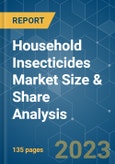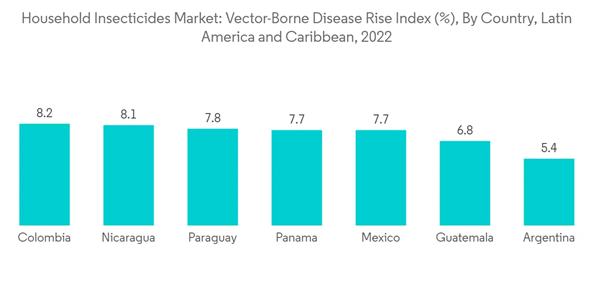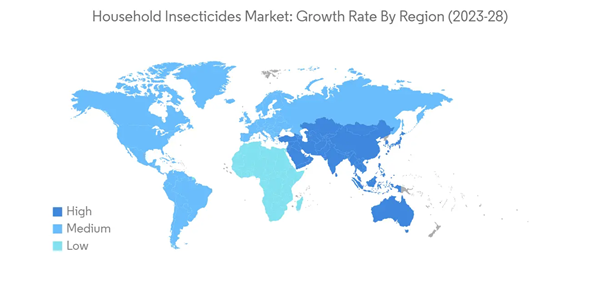Key Highlights
- Increased threats due to communicable diseases such as malaria and an increased emphasis on the control of insect vectors by local and national government bodies are expected to drive the market in the forecast period.
- To cater to the needs of household consumers, companies in the market are increasingly providing convenience through products that are easy to use and require minimal effort. In addition, there is a growing trend towards safer and more environment-friendly household insecticides. This has led to an increase in the usage of synthetic pyrethroids, which are considered to be safer than traditional insecticides.
- One of the major challenges facing the market is the emergence of insect resistance among insects. This has led to the development of new and innovative insecticides that are more effective and have a longer residual effect. Another challenge is the negative impact of insecticides on the environment and human health. This has led to increasing demand for more sustainable and eco-friendly solutions. Therefore, with an increasing focus on safer and more sustainable products, the industry is expected to grow during the forecast period, coupled with increasing new innovations and solutions aimed at improving efficiency and effectiveness in controlling insect vectors.
Household Insecticides Market Trends
Rising Prevalence of Insect-borne Diseases
- Insects, particularly mosquitoes and ticks, are responsible for the transmission of many diseases, such as malaria, dengue fever, Zika virus, Lyme disease, and West Nile virus, among others. There are several reasons for the rising prevalence of insect-borne diseases, including climate change, urbanization, and increased global travel.
- The global urban population is becoming more health-conscious, and people are becoming more aware of the risks of mosquito bites. Furthermore, as the number of diseases caused by mosquitoes increases in developing countries, the rural population is becoming increasingly concerned about health and hygiene.
- According to World Health Organization (WHO) report released in March 2020, vector-borne diseases accounted for more than 17% of all infectious diseases. Each year, these diseases cause more than 700,000 deaths. Additionally, the increase in air conditioning units and other appliances that hold water can provide breeding sites for mosquitoes.
- Climate change is one of the primary reasons for the increased prevalence of insect-borne diseases. As global temperatures rise, the geographic range of many insect vectors expands. For instance, the Asian tiger mosquito, a vector for dengue and Zika viruses, has spread to new parts of Europe and the Americas due to warming temperatures. Therefore, the rising prevalence of insect-borne diseases is a complex issue caused by a combination of factors.
Asia Pacific Dominates the Market
- The Asia-Pacific region is experiencing rapid urbanization and an increasing population, which has resulted in a rise in demand for household insecticides. With more people living in close proximity to each other, the chances of insect infestations and the spread of diseases increase. Additionally, the rising disposable incomes of people in this region have led to increased spending on household products, including insecticides.
- Vector-borne diseases like dengue fever are also a major concern in the Asia-Pacific region. Dengue fever is a mosquito-borne viral disease that has become a significant public health concern in many countries in this region. The rising incidence of dengue fever and other vector-borne diseases has led to increased awareness about the importance of keeping households insect-free. This has driven the demand for household insecticides in the region.
- Governments in the Asia-Pacific region have also taken steps to address the problem of vector-borne diseases. They have implemented awareness campaigns to educate people about the importance of keeping their homes insect-free and have also introduced regulations to ensure insecticides are used safely and effectively. Overall, the growth of the household insecticides market in the Asia-Pacific region is driven by a combination of factors, including population growth, urbanization, rising disposable incomes, and concerns over vector-borne diseases. The market is expected to continue to grow in the forecast period.
Household Insecticides Industry Overview
The household insecticides market is consolidated, with major players accounting for the majority of the share of the market. FMC Global Specialty Solutions, Godrej Consumer Products Limited, S.C Johnson & Son, Johnson and Johnson, Spectrum Brands, Natural INSECTO Products Inc., and others are some of the major players in the industry. Product innovation is a go-to-market strategy adopted by firms to increase market penetration in rural areas and consumption growth in urban areas. The players are also heavily focusing on developing integrated marketing communications like television, newspapers, Internet, and radio advertisements to increase sales.Additional Benefits:
- The market estimate (ME) sheet in Excel format
- 3 months of analyst support
Table of Contents
Companies Mentioned (Partial List)
A selection of companies mentioned in this report includes, but is not limited to:
- Amplecta AB
- FMC Global Specialty Solutions
- Godrej Consumer Products Ltd
- Natural INSECTO Products, Inc.
- Nicols International Sa.
- S.C. Johnson & Son
- Shogun Organics
- Spectrum Brands Holding










